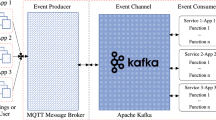Abstract
We propose a new multicast communication paradigm called “spatiotemporal multicast” for supporting applications which require spatiotemporal coordination in wireless sensor networks. In this paper we focus on a special class of spatiotemporal multicast called “mobicast” featuring a message delivery zone that moves at a constant velocity \(\vec v\). The key contributions of this work are: (1) the specification of mobicast and its performance metrics, (2) the introduction of four different mobicast protocols along with the analysis of their performance, (3) the introduction of two topological network compactness metrics for facilitating the design and analysis of spatiotemporal protocols, and (4) an experimental evaluation of compactness properties for random sensor networks and their effect on routing protocols.
Similar content being viewed by others
References
B. Blum, P. Nagaraddi, A. Wood, T. Abdelzaher, S. Son and J. Stankovic, An entity maintenance and connection service for sensor networks, in: First Internat. Conf. on Mobile Systems, Applications, and Services (MobiSys), San Francisco, CA, May 2003.
J. Boleng, T. Camp and V. Tolety, Mesh-based geocast routing protocols in an ad hoc network, in: Proc. of the IEEE Internat. Workshop on Parallel and Distributed Computing Issues in Wireless Networks and Mobile Computing (IPDPS 2001,pp. 184–193.
P. Bose, L. Devroye, W. Evans and D. Kirkpatrick, The spanning ratio of Gabriel graphs and ß-skeletons, in: Proc. of the 5th Latin American Symposium on Theoretical Informatics, 2002, pp. 479–493.
R.R. Brooks, C. Griffin and D.S. Friedlander, Self-organized distributed sensor network entity tracking, International Journal of High Performance Computing Applications 16(3) (2002).
A. Cerpa, J. Elson, D. Estrin, L. Girod, M. Hamilton and J. Zhao, Habitat monitoring: Application driver for wireless communications technology, in: ACM SIGCOMM Workshop on Data Communications in Latin America and the Caribbean, Costa Rica, April 2001.
M. Chu, H. Haussecker and F. Zhao, Scalable information-driven sensor querying and routing for ad hoc heterogeneous sensor networks, International Journal of High Performance Computing Applications 16(3) (2002).
T.H. Cormen, C.E. Leiserson and R.L. Rivest, Introduction to Algorithms (MIT Press, Cambridge, MA, 1999).
D. Eppstein, Spanning trees and spanners, in: Handbook of Computational Geometry, eds. J.-R. Sack and J. Urrutia (Elsevier Science, Amsterdam, 1999) pp. 425–461.
D. Estrin, Embedded everywhere: A research agenda for networked systems of embedded computers, Computer Science and Telecommunications Board (CSTB) Report, National Academy Press (2001).
W.R. Heinzelman, A. Chandrakasan and H. Balakrishnan, Energy-efficient communication protocol for wireless microsensor networks, in: Proc. of the 33rd Hawaii Internat. Conf. on System Science (HICSS 2000), 2000.
Q. Huang, C. Lu and G.-C. Roman, Spatiotemporal multicast in sensor networks, in: Proc. of the 1st ACM Conf. on Embedded Networked Sensor Systems (SenSys), Los Angelos, CA, 2003.
T. Imielinski and J.C. Navas, GPS-based addressing and routing, RFC2009, Computer Science, Rutgers University (1996).
C. Intanagonwiwat, D. Estrin, R. Govindan and J. Heidemann, Impact of network density on data aggregation in wireless sensor networks, in: Internat. Conf. on Distributed Computing Systems (ICDCS-22), 2001.
C. Intanagonwiwat, R. Govindan and D. Estrin, Directed diffusion: A scalable and robust communication paradigm for sensor networks, in: Mobile Computing and Networking, 2000, pp. 56–67.
Y. Ko and N. Vaidya, Geocasting in mobile ad hoc networks: Location-based multicast algorithms (1998), in: Proc. of the 2nd IEEE Workshop on Mobile Computer System and Applications, 1999.
D. Li, K. Wong, Y. Hu and A. Sayeed, Detection, classification and tracking of targets in distributed sensor networks, IEEE Signal Processing Magazine 19(2) (2002).
W.-H. Liao, Y.-C. Tseng, K.-L. Lo and J.-P. Sheu, Geogrid: A geocasting protocol for mobile ad hoc networks based on grid, Journal of Internet Technology 1(2) (2000) 23–32.
J. Liu, D. Petrovic and F. Zhao, Multi-step information-directed sensor querying in distributed sensor networks, in: Proc. of the Internat. Conf. in Acoustics, Speech and Signal Processing (ICASSP), 2003.
J. Liu, J. Reich and F. Zhao, Collaborative in-network processing for target tracking, EURASIP Journal on Applied Signal Processing 4 (2003) 378–391.
S. Madden, M. Franklin, J. Hellerstein and W. Hong, TAG: A tiny aggregation service for ad-hoc sensor networks, in: Proc. of the 5th Symposium on Operating Systems on Design and Implementation (OSDI 2002), Boston, MA, 2002.
G. Narasimhan and M.H.M. Smid, Approximating the stretch factor of Euclidean graphs, SIAMJournal on Computing 30(3) (2000) 978–989.
J.C. Navas and T. Imielinski, GeoCast–Geographic addressing and routing, in: Proc. of the 3rd Annual Internat. Conf. on Mobile Computing and Networking (MobiCom' 97), 1997, pp. 66–76.
S.-Y. Ni, Y.-C. Tseng, Y.-S. Chen and J.-P. Sheu, The broadcast Storm problem in a mobile ad hoc network, in: Proc. of the 5th Annual ACM/IEEE Internat. Conf. on Mobile Computing and Networking, 1999, pp. 152–162.
W. Peng and X. Lu, On the reduction of broadcast redundancy in mobile ad hoc networks, in: Proc. of the ACM Symposium on Mobile Ad Hoc Networking and Computing (MOBIHOC), 2000.
A. Qayyum, L. Viennot and A. Laouiti, Multipoint relaying: An efficient technique for flooding in mobile wireless networks, Technical Report, Research Report RR-3898, INRIA (2000).
I. Stojmenovic, Voronoi diagram and convex hull based geocasting and routing in wireless networks, TR 99-11, University of Ottawa (1999).
B. Williams and T. Camp, Comparison of broadcasting techniques for mobile ad hoc networks, in: Proc. of the ACM Internat. Symposium on Mobile Ad Hoc Networking and Computing (MOBIHOC), 2002, pp. 194–205.
H. Zhou and S. Singh, Content based multicast (CBM) for ad hoc networks, in: MOBIHOC 2000, Boston, MA, 2000.
Author information
Authors and Affiliations
Rights and permissions
About this article
Cite this article
Huang, Q., Lu, C. & Roman, GC. Design and Analysis of Spatiotemporal Multicast Protocols for Wireless Sensor Networks. Telecommunication Systems 26, 129–160 (2004). https://doi.org/10.1023/B:TELS.0000029036.55604.2a
Issue Date:
DOI: https://doi.org/10.1023/B:TELS.0000029036.55604.2a




